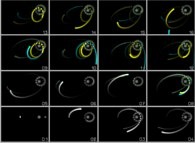![N-body problem integration (N=4: one star, one heavy planet and one light planet with a satellite) computed with 2 different optimization options on the same computer (sensitivity to rounding-off errors) [Intégration du problème des N-corps (N=4: une étoile, une planète lourde et une planète légère avec un satellite) calculé avec 2 options d'optimisation différentes (sensibilité aux ereurs d'arrondi) ] N-body problem integration (N=4: one star, one heavy planet and one light planet with a satellite)computed with 2 different optimization options on the same computer (sensitivity to rounding-off errors) [Intégration du problème des N-corps (N=4: une étoile, une planète lourde et une planète légère avec un satellite) calculé avec 2 options d'optimisation différentes (sensibilité aux ereurs d'arrondi) ]](image.jpg)
N-body problem integration (N=4: one star, one heavy planet and one light planet with a satellite) computed with 2 different optimization options on the same computer (sensitivity to rounding-off errors) [Intégration du problème des N-corps (N=4: une étoile, une planète lourde et une planète légère avec un satellite) calculé avec 2 options d'optimisation différentes (sensibilité aux ereurs d'arrondi)].
 and the sensitivity to initial conditions
and the sensitivity to initial conditions  .
.



